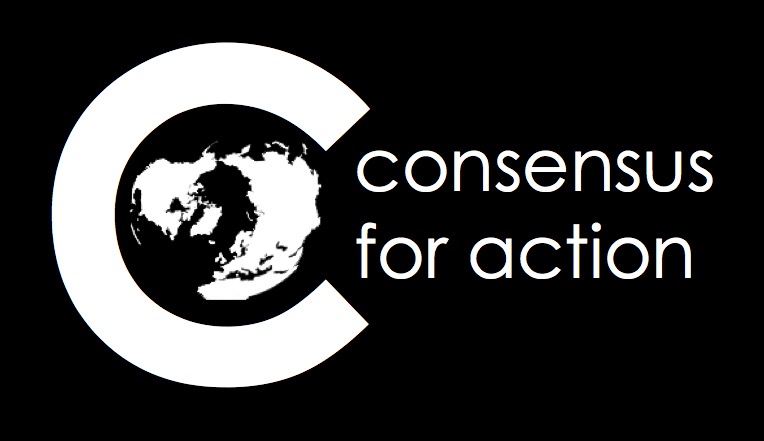Population Growth Is Driving the Migration Crisis
As the migrant crisis in Europe continues to heat up, everyone is quick to recognize the immediate cause: people are fleeing war-torn regions, this time primarily Syria and ISIS-controlled strongholds. But, hiding underneath that proximate cause is a long-term driver that will need to be recognized and dealt with if we hope to keep Europe’s migration crisis of today from becoming the new normal worldwide. That driver is rapid population growth.
As global change scientists who have long studied why species ebb and flow, we see over and over again that, in non-human species, when so many offspring are born that food and living space become too scarce for comfort in the species’ home range, the youngsters make the risky decision to disperse, in search of new territory and a richer life. So, too, with the human race. It is no coincidence that migrants are fleeing exactly those regions where population growth has been extremely high over the past couple of decades. Birth rates up to four times higher than in most European countries have, over the past three decades, nearly doubled the population of the top migrant-producing countries today.

Would-be immigrants at the Greek-Macedonian border. Photo via Wikimedia Commons, By Bundesministerium für Europa, Integration und Äusseres (Arbeitsbesuch Mazedonien), originally posted to Flickr by Österreichisches Außenministerium
As people escape poor, dangerous living conditions they flow towards nations with more resources, which typically also have lower birth rates and more stable population densities. Such immigration is now fueling population growth in many developed countries, including western Europe, despite those countries exhibiting birth rates so low that the number of old “native-born” residents are beginning to outnumber the young. Europe is not alone in seeing a migrant influx, of course: the USA houses more immigrants than any other country, some 20% of the world’s migrants.
What connects the dots of too-rapid population growth, war, and migration? Rapid population growth ultimately results in an intensified competition for resources, jobs, and even such basics as food and water. If this takes place where long-standing animosity between different religious and/or ethnic groups also exists, the situation ignites into full-on war, and people literally flee for their lives. That is exactly the case where ISIS has been expanding strongholds, and why, in 2014, war-torn Afghanistan, Syria, Sudan, South Sudan and Somalia accounted for nearly 20 million of the refugees knocking at the doors of other nations. These areas saw their populations increase between 66% and 160% since 1990, compared to the world average of 27%. In fact, greater than 60% population growth and internal war since 1990 marks fifteen of the twenty-two countries that consistently produced most refugees in the 21st century.
As we go into the future, all demographic models show population continuing to skyrocket in the poorest countries, notably in Africa and the Middle East, including many nations already showing internal conflict. Exacerbating the problem will be impacts of human-caused climate change. Already, unusual climate events have contributed to the refugee-producing crises in Southeast Asia, northeast Africa, and to the Arab Spring uprising, and it is exactly the poorest, most densely populated, and politically least stable regions of the world that are predicted to be hit hardest by rising sea levels, disruption of water and food supplies, and energy shortages slated to intensify as the world tips into a new climate regime. This is the perfect recipe to continue to feed mass migrations.
Without full recognition of these underlying drivers, immigration problems will certainly intensify. Walls and rhetoric will never solve the problem. Refugees will continue to pour across borders by air, land, and sea. However, recognizing that rapid population growth plays the key role in triggering mass migration reveals solutions to the problem that will be effective in the long term.
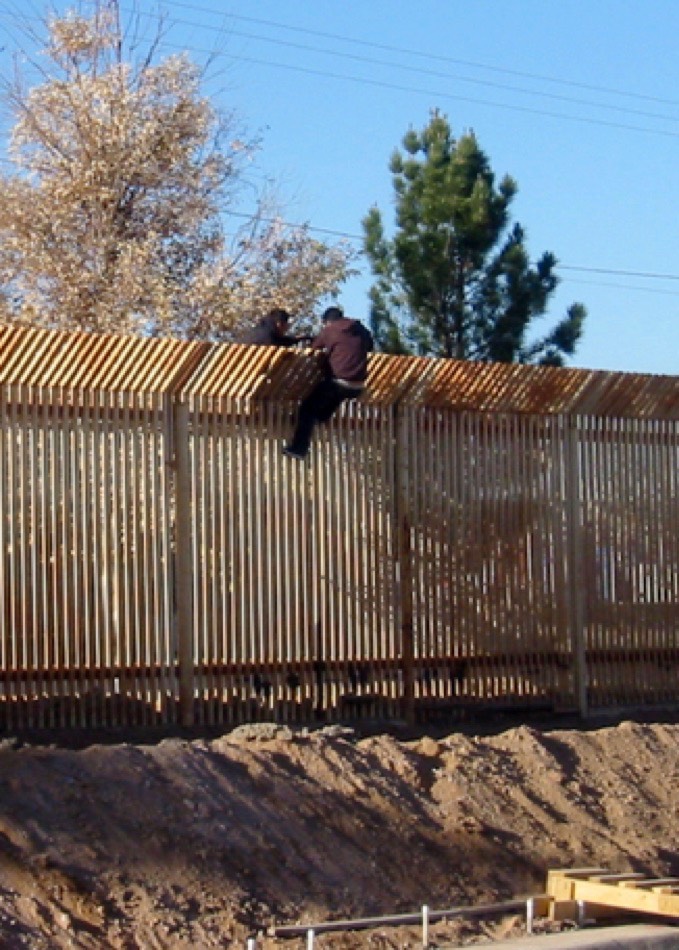
Scaling the border wall between Mexico and Arizona. U.S. Navy photo by Steelworker 1st Class Matthew Tyson, via Wikimedia Commons.
One critical piece of the solution will be to address the overarching problem of rapid, unsustainable population growth by international programs that provide educational opportunities and basic health care to women in parts of the world where they currently are unavailable. Numerous studies document the rapid reduction of birth rates that result.
Another is international cooperation to improve living conditions in poor parts of the world, and to stabilize fragile governments.
At the same time it will be essential to minimize climate disruption to prevent relocation of hundreds of millions of climate refugees. This can be accomplished through rapid transition from fossil fuels to renewable energy production in the developed world, and leapfrogging over fossil fuels to produce clean energy in developing countries.
Finally, the most important ingredient may well be the heightened influx of immigrants now underway, which provides rich opportunities to learn how to live alongside people from distant lands. Ultimately, fixing the global problems that lead to the immigration crisis will require tolerance and melding of ideas and knowledge from all the diverse cultures that comprise the human race. By accepting the biological realities of immigration, and embracing the chance to learn about each other, we just may be able to build a global society that is more vibrant in the coming decades, rather than one that is increasingly fragmented by fear and isolationism.
By Elizabeth A. Hadly, hadly@stanford.edu and Anthony D. Barnosky, barnosky@berkeley.edu
Hadly and Barnosky are professors of biology at Stanford University and University of California at Berkeley, respectively, and authors of the new book: End Game, Tipping Point for Planet Earth? (2015, HarperCollins / WilliamCollins, London), which will be published in the United States in April under the title Tipping Point for Planet Earth: How Close Are We To The Edge? (Thomas Dunne / St. Martin’s Press, New York).
Musings on the Wild: Part 6
By Anthony D. Barnosky, Professor in the Department of Integative Biology, Curator in the Museum of Paleontology, and Research Paleoecologist in the Museum of Vertebrate Zoology at the University of California, Berkeley. His new book Dodging Extinction: Power, Food, Money, and the Future of Life on Earth (University of California Press, Fall 2014) explores in more detail how people can keep wild species and wild places on Earth.
(This is the last blog in the Musings on the Wild series.)
Survival?
I sometimes wonder if I'm a dying a breed. Is this what it feels like to get old? Watching what you love slip away, little by little, until it’s a sorry remnant of what it used to be?
The wild, at least my kind of wild, is certainly a remnant nowadays, but thankfully not yet a sorry one. These days in the Okavango have renewed my faith that. Once again I'm just back from safari, contemplating the quiet of the elephants we saw this morning. They were booking it across the brown grass, heading from one patch of marula trees to the next in single file, with mama in the lead, the matriarch I guess, and her baby second in line struggling to keep up. Was the hyaena crooning in the distance, back in the area from which the elephants were streaming, signaling something that had put them on the move? Was that hyaena why the baby had only a fresh bloody stump where its tail should be? Or were the elephants just in a hurry?

Maybe the eagle we saw knew the answers, but I never will, and that's just fine with me.
I wonder, though, how many other people are there out there like me, who would find it a tragedy if there were no longer places to experience this? Who would understand that without wild places, there would be no more serenity in the world? It's a shrinking wilderness out there, for sure, and maybe our capacity to find happiness shrinks right along with it.
That's my view anyway. I think the only hope for wilderness, for places where wild landscapes and wild species both remain, is if there actually is a critical mass of people who share my view. Those who live in these places certainly do, so that's one good thing. Another is that in my many years and many trips into the wild, I've come across only a tiny minority who, after experiencing such places, do not come away feeling richer for it. I think there's something genetic there.
Of course, that may well be a self-selected sample of humanity. I mean, why visit such places if you don't think it will be something you'd like? I can also remember a couple of people I took on back country trips that ended up downright freaked out by the feeling that there was no grocery store, no doctor, no way to connect with the outside world that didn't take a day or two walking, riding a horse, or bouncing your four-wheel drive vehicle along bumpy two rut roads.
My fear is that the fear of those people is becoming the global norm. There's probably something genetic there too.
Maybe it's that fear that's in a large part causing the wild to disappear. We think of taming wilderness as progress, but maybe it's just the biology of the shifting human gene pool. Maybe deep down, we're evolving from a Homo sapiens defined by our connection to other species, to a new kind of human defined by fear of what we can't control.
 And there's a lot you can't control in the
wild. This morning we came upon a den of
wild dogs. This is the second litter of
pups they've had this season. Turns out
that the first litter, along with their mom, ended up in the stomachs of lions,
all in one fell swoop. Wild dogs are
pretty cagey, but a few minutes of letting your guard down at the wrong time,
and there you have it. You wouldn't be
wrong in calling that a violent death, but then again, we humans have our own
versions of that. Walk into the wrong
neighborhood in just about any big city and let your guard down and you'll see
what I mean.
And there's a lot you can't control in the
wild. This morning we came upon a den of
wild dogs. This is the second litter of
pups they've had this season. Turns out
that the first litter, along with their mom, ended up in the stomachs of lions,
all in one fell swoop. Wild dogs are
pretty cagey, but a few minutes of letting your guard down at the wrong time,
and there you have it. You wouldn't be
wrong in calling that a violent death, but then again, we humans have our own
versions of that. Walk into the wrong
neighborhood in just about any big city and let your guard down and you'll see
what I mean.
So we try to control our lives and the bad things that can happen. We don't walk into those bad neighborhoods. If we do—hell, even if we don't—we buy a gun and learn to shoot it. And we stay out of the wild, or if we do go in there, we arm ourselves and assume every one of the predators there is out to get us.
Yet here's a paradox. One big difference we've noticed between the safari camps and guides in South Africa and Botswana, which is to say, between the faux-wild (game reserves) and the really wild (Okovango Delta): in the truly wild places, they don't carry guns. Here's an interesting story: in our camp now there's a bush buck with a baby. A leopard has been coming into camp pretty much every night trying to get that thing for a meal. Walking to our tent last night, we saw the leopard, maybe twenty yards away. It's a rule of thumb around here that you don't go anywhere at night without a guide that knows the routine, and in this case the routine was simply to shine a flashlight in the leopard's eyes. Sure enough, he cowered behind a tree until we were gone, then went about his business. Later on, we heard the bush buck weakly barking—it sounds a lot like a dog—and a scuffle, and we figured that was all she wrote. But, bush buck and baby were still there today, so I'm not sure what the commotion was about.
Anyway, life goes on, even after those violent events. Now there's a new alpha female in the wild dog den we saw this morning. We heard her new litter of pups squeak and yelp, and watched her coaxing her pack mates, fresh back from the hunt, for more food. A couple of them lazily scratched their fleas and stretched out on the termite mound they've burrowed into and call home.
And, like that family of wild dogs, after every murder in the inner city, every school shooting, we too pick up the pieces and go on.
My point is, I don't think that it's violence we're really running from when we run from the wild, when we try to tame it. It's all about control. And that brings me in a very big circle, because now, in an attempt to save the little wild we have left, we're starting to sneak in more and more control.
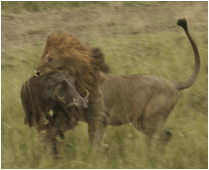 I'm reminded of something we witnessed two
years ago, on Kenya's Masai Mara. We
watched some lions take down a warthog. There were two prides involved, at
least nine lions. One of the males had a
deep gash on his head, presumably from duking it out with another male: we
called him Scarface. Another male suddenly dashed in to take the warthog from
the four lionesses that had killed it, picking up the 200-pound warthog in his
teeth like it was nothing and carrying it off.
This, mind you, was about as wild a place as you are going to find on
Earth; we were at the beginning of the wildebeest migration, the last great
natural phenomenon of its kind.
I'm reminded of something we witnessed two
years ago, on Kenya's Masai Mara. We
watched some lions take down a warthog. There were two prides involved, at
least nine lions. One of the males had a
deep gash on his head, presumably from duking it out with another male: we
called him Scarface. Another male suddenly dashed in to take the warthog from
the four lionesses that had killed it, picking up the 200-pound warthog in his
teeth like it was nothing and carrying it off.
This, mind you, was about as wild a place as you are going to find on
Earth; we were at the beginning of the wildebeest migration, the last great
natural phenomenon of its kind.
Then, almost two years later, an e-mail came into my in-box, from one of the travelers who had been with us on that trip. He'd run across a news article that said one of the lions in Scarface's pride had been pretty badly torn up in a fight. A picture showed this lion with a huge flap of skin hanging off its side, below a bloody patch of muscle and ribs about the size of a of dinner plate, maybe bigger. The gist of the article was that the injured lion had been anesthetized by a team of veterinarians; its side had been stitched up, and it was doing well.
So there we go again, exerting control, but maybe this time it was for the right reasons? For better or worse, we gave that lion a chance to fight another day because lions, like many other large predators, are now so few in number they are in danger of extinction. Like me, maybe they're a dying breed.
But, maybe we can turn that around. Stitching up a lion is no easy or cheap feat. We can argue about whether or not that was the right call, but the fact that somebody is still willing to take that trouble on makes me know there are others like me out there. And if there are enough of us, all willing to do what we can, the wild might yet survive. Which would mean, our version of Homo sapiens, like the wild we love, also would live on.
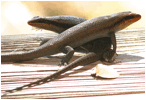
I'm keeping my fingers crossed that all works out. Meanwhile, I just finished watching a four-foot-long monitor lizard glide out of the tall grass in front of me, and two smaller lizards going through an elaborate courtship ritual on the tent porch. For now, those things will have to be enough.
Musings on the Wild: Part 5
By Anthony D. Barnosky, Professor in the Department of Integative Biology, Curator in the Museum of Paleontology, and Research Paleoecologist in the Museum of Vertebrate Zoology at the University of California, Berkeley. His new book Dodging Extinction: Power, Food, Money, and the Future of Life on Earth (University of California Press, Fall 2014) explores in more detail how people can keep wild species and wild places on Earth.
(This is the fifth of six blogs about my reflections on wild places and wild species—what they are and why they are important—written as I traveled through parts of Africa this past summer.)
Feeling Wild
My soul is at peace. That's how I know I'm in the wild.
 Maybe part of it is that it feels like
autumn, always my favorite season. Here
in Botswana's Okavango Delta, though, it's technically winter and what I'd call
an Indian summer day where I come from is occurring in late June, not late
September. Maybe part of my contentment
is because I'm sitting here in the shade, outside the little tent cabin Liz and
I are sharing, looking out on waving marsh grass, heads like feathers, but much
taller than my own six feet of humanity.
Breaks of blue-green water peek out of the grass. We're on a meander that is right on the edge
of the delta.
Maybe part of it is that it feels like
autumn, always my favorite season. Here
in Botswana's Okavango Delta, though, it's technically winter and what I'd call
an Indian summer day where I come from is occurring in late June, not late
September. Maybe part of my contentment
is because I'm sitting here in the shade, outside the little tent cabin Liz and
I are sharing, looking out on waving marsh grass, heads like feathers, but much
taller than my own six feet of humanity.
Breaks of blue-green water peek out of the grass. We're on a meander that is right on the edge
of the delta.
In the middle of the night we heard hippos splash out of the water and spend some time munching the grass right outside the canvas walls. On safari this morning, it was quiet when we killed the engine, only the sound of the breeze, birdsong, the rustling of the grass. Even the elephants were quiet, as we parked there in the midst of a herd that milled around us. I counted at least fifty; it's my guess the real number was close to a hundred.
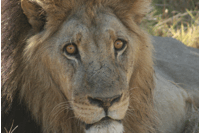 Likewise the lions we came across were
serene, resting in the shade, all three of them lazy males. Liz spotted them there in the tall grass, two
of them sprawled out sound asleep, the other one with his paws stretched out in
front, hind quarters cocked to the side, head up, quietly watching us watch
him. Crocodile on the bank, fish eagle
in the tree, pelicans and flamingoes herding fish in a drying out pond. Nobody seemed to have a care in the world.
Though I suspect the fish did.
Likewise the lions we came across were
serene, resting in the shade, all three of them lazy males. Liz spotted them there in the tall grass, two
of them sprawled out sound asleep, the other one with his paws stretched out in
front, hind quarters cocked to the side, head up, quietly watching us watch
him. Crocodile on the bank, fish eagle
in the tree, pelicans and flamingoes herding fish in a drying out pond. Nobody seemed to have a care in the world.
Though I suspect the fish did.
The other thing is the smells. At one point there was sage—sweeter than the sagebrush I'm used to, but familiar enough to make me feel good. Marsh mud, not strong, tempered by the hay-smell of drying grass. And unfamiliar, yet familiar: animals, different kinds, that had recently gone by, and more pungent yet (but in a good way), the earthy smell of elephant droppings.
Getting here is not all that easy, and I'm sure that's one of the things that makes it my kind of wild. We took the quickest route, a thirty-minute flight from Maun in a seven-seat bush plane. From our vantage it was easy to see why driving to the Okavango from our takeoff point would entail six to eight hours in the best of conditions, much of it on a two rut road, and a couple of days if the water is running high, even though it's only an 80 mile drive, give or take.
 We're here when the water is fairly high.
The rainy season in Angola stopped more than a month ago, but it's taken all
this time for the water to finally make its way along the Namibian border and
spread out in a broad fan here, where tectonic warping has dropped the land
surface a little lower than up north.
From our bird’s eye view, the result looks like loosely braided blue-black
ribbons, which are actually of water.
Between each of the watery strands are islands and strips of land, some
big, some small, but all of them with their concentric bands of bright green
next to the water giving way to golden brown a little higher up where the
grasses have already dried, to deeper forest or olive green in the places where
the trees never get drowned. As the
season goes on we're told, the bands of brown get wider, and the bright green
marshy areas and blue water begin to disappear under the relentless African
summer sun.
We're here when the water is fairly high.
The rainy season in Angola stopped more than a month ago, but it's taken all
this time for the water to finally make its way along the Namibian border and
spread out in a broad fan here, where tectonic warping has dropped the land
surface a little lower than up north.
From our bird’s eye view, the result looks like loosely braided blue-black
ribbons, which are actually of water.
Between each of the watery strands are islands and strips of land, some
big, some small, but all of them with their concentric bands of bright green
next to the water giving way to golden brown a little higher up where the
grasses have already dried, to deeper forest or olive green in the places where
the trees never get drowned. As the
season goes on we're told, the bands of brown get wider, and the bright green
marshy areas and blue water begin to disappear under the relentless African
summer sun.
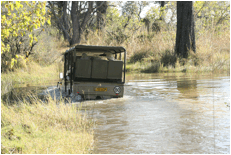 The fluctuating water levels and deep sand
it leaves behind are why there are few roads into this place, and of those
there are, why parts of them are submerged by water and impassable for much of
the year. Even now, it can be touch and
go. This morning we dipped our land rover nose-deep into a couple of ponds the
road runs through, and I wasn't all that sure we'd make it to other side. We always did, but not so for two other
vehicles in our party, who apparently spent much of their morning stuck in a
thigh-deep water crossing. Where there
wasn't water on the road, the sand can make travel tricky—in
one place this morning, our wheels just spun, land rover stationary, sand
flying, in a maneuver that got us going, but just as easily could have dug us
down to our axle.
The fluctuating water levels and deep sand
it leaves behind are why there are few roads into this place, and of those
there are, why parts of them are submerged by water and impassable for much of
the year. Even now, it can be touch and
go. This morning we dipped our land rover nose-deep into a couple of ponds the
road runs through, and I wasn't all that sure we'd make it to other side. We always did, but not so for two other
vehicles in our party, who apparently spent much of their morning stuck in a
thigh-deep water crossing. Where there
wasn't water on the road, the sand can make travel tricky—in
one place this morning, our wheels just spun, land rover stationary, sand
flying, in a maneuver that got us going, but just as easily could have dug us
down to our axle.
The lack of roads into and through this area is one aspect that makes it feel wild—indeed, actually makes it wild. But the Okavango Delta also blends the two other characteristics I've come to realize define wild for me: not only landscapes untamed by people, but in those landscapes, animals untamed by people. My wild has to have both.
And the Okavango Delta does. The delta does what it wants: when the river is high, the going gets tough, and when the river is low, things get easier, for people anyway. My point is that we don't control this river—it does what it wants. The river controls us. Likewise, nobody is controlling the animals that live here. They come and go as they have for millennia, with the rhythms of the river and the seasons. No fences in sight, once you leave the camps.
 The animals seem not too worried by
humans, but they don't seem tame. It's more like a tacit understanding between
the animals and people—you don't mess with us, we won't mess with you. I'm willing to bet it's pretty much the same
tacit understanding that has existed between people and the animals here since Homo
sapiens evolved. Maybe it's not too
different from whatever signal the lions we saw today were giving to the herd
of impalas that were also in our sightline:
don't sweat it impalas, too lazy to hunt right now, but don't let your
guard down.
The animals seem not too worried by
humans, but they don't seem tame. It's more like a tacit understanding between
the animals and people—you don't mess with us, we won't mess with you. I'm willing to bet it's pretty much the same
tacit understanding that has existed between people and the animals here since Homo
sapiens evolved. Maybe it's not too
different from whatever signal the lions we saw today were giving to the herd
of impalas that were also in our sightline:
don't sweat it impalas, too lazy to hunt right now, but don't let your
guard down.
I used to think that Paul Martin's old explanation of why megafauna survived in Africa, while succumbing to human pressures most everywhere else, was pretty ad hoc. He thought that since humans and the big animals evolved together in Africa, they reached some ecological arrangement early on that basically said live and let live, except when you were hungry enough. Maybe he wasn't so far off though—that's sure what the lions were saying to the impalas today.
Sitting here in the afternoon sun it's seeming less and less farfetched to me that early humans slotted into the overall ecosystem the same way. Surely, that's the message we got, and gave, to dozens of wild species this morning.
It's ironic. It's solace, and it's peaceful, but it's wild.
Musings on the Wild: Part 4
By Anthony D. Barnosky, Professor in the Department of Integative Biology, Curator in the Museum of Paleontology, and Research Paleoecologist in the Museum of Vertebrate Zoology at the University of California, Berkeley. His new book Dodging Extinction: Power, Food, Money, and the Future of Life on Earth (University of California Press, Fall 2014) explores in more detail how people can keep wild species and wild places on Earth.
The Mighty Zambezi
It's not Victoria Falls, or the Zambezi River around here. It's the MIGHTY Victoria Falls, and the MIGHTY Zambezi River. The why of that is pretty obvious when you see the falls, but that comes later. First we hopped on a small boat and went upriver a ways. The safety instructions were pretty casual, and life jackets weren't a part of the program. Much more critical was the location of the anchor. Which makes sense, I guess, when you consider we were only a mile or so above the falls.
You wouldn't want to go over them, of course, so in case of trouble, say, a stalled motor, you'd want to drop that anchor fast. If you didn't, your fate would be the same as befalls the occasional elephant or hippo who gets caught in a stronger current than they were counting on as they try to swim to or from one of the many islands that pepper the mighty Zambezi: a fast ride to a very watery grave. The other essential part of the safety lecture involved knowing where the liquor was: Mosi beer, gin, whiskey. Drink your fill, we were told, and then our boatman pointed the bow upstream and we were on the way.
This was a different take on the wild. Elegant hotels on the Zambia side, and I presume the same across the river in Zimbabwe, but in the river and on its islands, crocodiles, monitor lizards, hippos, elephants. Somehow, those river-bound animals seemed wilder than most of what we'd seen in the South African game reserve. They were more shy, for one thing. Some of them seemed a little crabbier—we hightailed it out of one area when a hippo took offense at us, first lifting his backside out of the water and cranking his tail like a propeller to spread his feces in order to mark his territory. Then he disappeared under water, and surfaced at our stern heading our way. Or maybe he was just cranky with the elephants chomping down the tall grass on the marshy island, grass he was probably hoping to eat that evening.
The crocodiles seemed for the most part unfazed by us, or anything else, although a couple of them did slip into the water as we approached. That made it pretty clear why lifejackets weren't really a big part of the safety program. Maybe too that's why we were encouraged to drink our fill. If you go overboard in these waters, there would be certain advantages to being appropriately anesthetized.
I got the feeling that the river ruled these islands, not people. It's a force of nature clearly beyond our control—at least in stretches like that part of the Zambezi we were on, that still respond to the ebb and flow the moisture falling hundreds of miles upstream in their drainage basins, and that have not yet been tamed by a dam. So I'm thinking that to really be "wild," a place has to have a big element of untamed, by which I mean, cannot be controlled by people.
Or at least, people's control has to be a lot less than what is out of their control.
That is definitely the case for the mighty Victoria Falls themselves. A walk along the rim makes that readily apparent. The first thing you see is the mist; actually, you see that from miles away, but when you get close, it's mist and double rainbows. Further into the cloud of spray, the water crashing over the lip of the basalt precipice becomes visible and as you sweep your gaze to the left, you see more, and more, and more foamy white wall, but you never see the other side. It goes on out of your line of sight. Farther along the trail, you run into the most intense rainstorm you'll ever walk through, but it's not rain. It's the mist from the falls, and you keep getting drenched for several hundred yards. What goes up must come down, and what's coming down are sheets of water drops falling from the blue sky. I'm soaked to the skin in seconds, but it feels good. This is all engulfing. The only sound is the roar of the falls.
Click the picture to hear the roar of the falls (QuickTime Required)
That's wild, but it's not alive. So for me, it's not totally wild, because wild means wild living things as part of the landscape too. There are no big cats on the Zambia side—we're assured they've all been "taken care of." We're safe.
Actually though, there are big cats, but well confined as money makers for an outfit that provides the opportunity for interlopers like me to "walk with the lions." I couldn't bring myself to do that. It just seemed wrong, to go against my grain. Not least of which because the lions are "orphans." I mean, just how many ways can a lion cub become an orphan, without the intervening hand of man?
That's just me though. Several in our group bought tickets and not only walked with the lions, but also petted them (only on the back though; apparently you are supposed to stay away from their ticklish ears and heads). They loved it, and I suspect I would have too. Before they went, I asked a couple of them to find out what happens to the lions after they get too big to "walk with," when they begin to get close to full grown. The report is that the orphans at that point are taught to find their own food increasingly without human help, and when they are ready, they are placed back into the "wild," in places where lion populations are in trouble. Which of course theoretically would give a wide choice of areas to place them.
That is a rosy picture, and I hope it's true. If so, I'm ok with it, I guess. The lions help local people make a living, and the local people help lions stay on Earth. I think I'd want to run down exactly where those orphan lions come from though, and where they end up. While here we've also been told of lion "farms" that raise the animals to adulthood in order to drop them into big-game hunting preserves, a misnomer in my mind, in that the animals are bought and paid for in advance, and the hunter is led to the right place to execute it. That too helps keep lions on Earth, in an odd way. I've hunted myself, and I’ve got nothing against hunting when it's a fair fight. But I don't see much difference between the canned hunting that takes place in some of those hunting preserves and leading a lamb to the slaughter.

The Zambezi River is in the background.
Photo courtesy of Elizabeth Hadly.
It's a complicated question, this business of keeping wild animals from going extinct. Our colonial-era hotel sits right on the bank of the Zambezi, so the hippos and elephants occasionally wander up onto the nicely manicured lawn. I guess they are to some extent habituated to people, but they're still the boss. That's a step up from the zebras and giraffes that roam the property, which eat out of troughs the grounds keepers fill.
So there you have it. This area around the mighty Victoria Falls is wild in the river, and tame on the bank. It's one way for people to share common ground with some other big animals that are vulnerable to extinction. Game reserves like the one we came from in South Africa are another. But the problem for me is, those solutions make my version of the wild a thing of the past.
I want a version of wild that feels wild.
(Next week: the Okavango Delta in Botswana.)
Musings on the Wild: Part 3
By Anthony D. Barnosky, Professor in the Department of Integative Biology, Curator in the Museum of Paleontology, and Research Paleoecologist in the Museum of Vertebrate Zoology at the University of California, Berkeley. His new book Dodging Extinction: Power, Food, Money, and the Future of Life on Earth (University of California Press, Fall 2014) explores in more detail how people can keep wild species and wild places on Earth.
Peep Show
(This is the third of six blogs about my reflections on wild places and wild species—what they are and why they are important—written as I traveled through parts of Africa this past summer.)
Sitting in the Nelspruit airport waiting for a flight to Zambia, I'm still troubled about this wild thing, maybe even more so after last night. Last night we returned to the place where the leopards hang out.
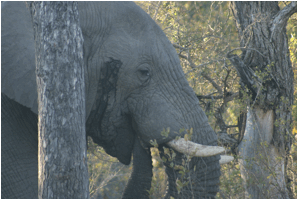 On the wild side was this: we came across that big bull elephant in rut,
seems like the same one we had the encounter with on foot a couple of days
ago. This time we were in our land
rover, but even so he was about twice our size.
He had a standoff with another land rover that was ahead of us. From a distance, we watched him glare at it,
wave his ears, stamp his foot, and then start to move forward. The land rover moved backward as fast as
prudence dictated, executed one third of a three-point turn, and headed off in
another direction. Our driver knew
enough to just sit there awhile, let the big guy turn around and amble down the
road a bit, and then we followed, keeping enough distance between us and him,
maybe fifty yards or so. Though our
prime view was of his rear end, every now and then he'd swing his head side to
side, enough to give us a clear view of a dark stripe of pungent ooze dripping
out of his musth gland.
On the wild side was this: we came across that big bull elephant in rut,
seems like the same one we had the encounter with on foot a couple of days
ago. This time we were in our land
rover, but even so he was about twice our size.
He had a standoff with another land rover that was ahead of us. From a distance, we watched him glare at it,
wave his ears, stamp his foot, and then start to move forward. The land rover moved backward as fast as
prudence dictated, executed one third of a three-point turn, and headed off in
another direction. Our driver knew
enough to just sit there awhile, let the big guy turn around and amble down the
road a bit, and then we followed, keeping enough distance between us and him,
maybe fifty yards or so. Though our
prime view was of his rear end, every now and then he'd swing his head side to
side, enough to give us a clear view of a dark stripe of pungent ooze dripping
out of his musth gland.
The bull at one point stepped off the road, put his shoulder against a tree that was three times his height and with a trunk the girth of his leg, and then began to push. You could see him strain, the tree began to bend, creak, and crackle, but it held. He tried again, same result, and then he wrapped his trunk around it and began pulling. The tree wouldn't give in though, which I guess speaks to how deep and extensive its root system must be. At last the elephant gave an audible sigh of disgust, and contented himself by reaching skyward with his trunk, wrapping it around a branch about as big around as my leg and twice as tall as me, and with one good tug he splintered it off. Then he got down to business chewing off the sweet bark, using his trunk to gently rotate it as he threaded the branch through his jaws. The portion of the branch that went in one side of his jaws was covered with rough gray bark; he'd work it with his trunk to push it sideways into the void of his mouth, and it would come out the other side clean and gleaming creamy white, kind of like de-barking a tree in a sawmill. Eventually he had enough, and resumed his slow, deliberate stroll down the road.
 On the tame side. A sundowner stop, gin and tonics, and an
orange African sunset silhouetting black
trees, their branches like intricate river networks gathering stars from the
darkening sky. Eventually the trees faded into the black of the night, the
Southern Cross lit up, and the Milky Way shone spectacularly bright.
On the tame side. A sundowner stop, gin and tonics, and an
orange African sunset silhouetting black
trees, their branches like intricate river networks gathering stars from the
darkening sky. Eventually the trees faded into the black of the night, the
Southern Cross lit up, and the Milky Way shone spectacularly bright.
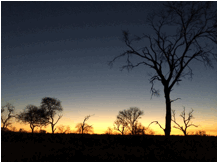
It was under that night sky we returned to the wild, or at least what initially seemed that way. Word came again on the radios: the leopards had been spotted. We were bushwhacking through dense underbrush to follow them. Three land rovers, each with their spotlights, now totally off road, crashing and snapping through the thicket where the leopards were hunting cane rats. By then in my mind, the leopards were fugitives on the run, and we were the yahoos with dogs about to put them in chains.
And then, there they were. There was no snarling, panicked attempt to get out of our spotlight beam. Instead, the male stretched out on his belly and crunched happily on a cane rat he'd just caught, not a care in in the world. The female patiently lay a few yards a way, with what I soon came to realize was a dreamy look of anticipation in her eyes.
And it wasn't anticipation for a bite of cane rat. She had something far more primal on her mind. After the male ate every last morsel, he licked the blood off his paws, going through very much the same ritual as your house cat after a meal. Suddenly he stood, and in two or three strides he was on the other side the female, whereupon he once again plopped down in the tall soft grass, head up, calmly checking us out.
As he'd gone by the female, she'd given a soft growl, something like a loud purr, but more menacing. Now she was up, brushing by the male, making body contact, giving him a good whiff of her hind end. He growled, she moved off. But in a minute or so, the same routine. Next thing we knew the male's on top, a sound like leopard laughter, he's biting the back of her neck. In less than ten seconds it’s over. We've just seen leopards mate. In the wild?
This is where it gets tricky for me. We watched three rounds of that mating routine, and we weren't the only ones. Three land rovers surrounded those leopards on one side, a tracker in each shining their bright lights on the whole event. It was eerily like the leopards were in the spotlights on a grassy stage, a thorny thicket as the backdrop. And us, and the twenty other people observing the show, we were like paparazzi, the number of camera flashes intensifying pretty much in rhythm with the fireworks presumably lighting up the leopards' synapses.
 If it all sounds a bit like the porn
version of Wild Kingdom, with us as the both film crew and audience, well,
that's pretty much what it was.
Afterwards our guide told us that those leopards have become completely
used to the land rovers over the past few years, and that the after-sun-down
chase has become about as familiar to the leopards as your evening cocktail is
to you. It's just what happens right
after the sun goes down. That wasn't too
hard to believe. Certainly the leopards
noticed us just about as much you'd notice a fly on the wall; we may as well
have been another tree as far as they were concerned.
If it all sounds a bit like the porn
version of Wild Kingdom, with us as the both film crew and audience, well,
that's pretty much what it was.
Afterwards our guide told us that those leopards have become completely
used to the land rovers over the past few years, and that the after-sun-down
chase has become about as familiar to the leopards as your evening cocktail is
to you. It's just what happens right
after the sun goes down. That wasn't too
hard to believe. Certainly the leopards
noticed us just about as much you'd notice a fly on the wall; we may as well
have been another tree as far as they were concerned.
Except right at the end. The male finally had had enough, whether of the female, or of us, I have no idea. But he rose to his feet, and walked towards our land rover. For one brief second, maybe two, he lifted his eyes and stared into ours, and in that second, it was absolutely clear that he was predator, we were prey. He suddenly turned, our tracker lifted his feet out of the way as the leopard passed under them, and then both leopards melted back into the dark. Show over.
So, did I experience the wild? Certainly it was thrilling, and probably a once in a lifetime experience. I wouldn't trade it. But wild?
Now I'm on the plane flying north towards the next destination, Victoria Falls. It's a bigger jet this time, so I'm far above the fray on the ground. I did notice as we took off though, there was a dammed river below, and they were being careful about controlling the flow: the riverbed below the dam was almost dry. All around the reservoir, flames from more-or-less controlled burns were sending their smoke to the sky, the haze largely responsible for that beautiful orange sunset I'd so much enjoyed the night before.
Reflecting on it all, two images come to mind. One is sitting on a tour bus, driving through the streets of Soweto, a world much more foreign to me than the African, or any other backcountry. I was nothing but a voyeur in Soweto, while being shown all the classic sights: the gold mine tailings, the old miners barracks, Nelson Mandela's house, the site of the 1976 tragedy when the police opened fire on marching school kids, the nicer homes that have started to spring up in post-apartheid times, and pockets of truly destitute slums, where goat pens were right next to tattered-tarp family dwellings. When we stopped for lunch there, some dancers dressed in traditional Botswana knock-off costumes performed for us.
The other image is those mating leopards. I was nothing but a voyeur there too, staring down from above in my land rover seat.
Maybe there's a difference between those two experiences, but I'm not sure yet what it is. One thing I do know. What I yearn for in the wild is being in it, not just being shown it.
Musings on the Wild: Part 2
By Anthony D. Barnosky, Professor in the Department of Integative Biology, Curator in the Museum of Paleontology, and Research Paleoecologist in the Museum of Vertebrate Zoology at the University of California, Berkeley. His new book Dodging Extinction: Power, Food, Money, and the Future of Life on Earth (University of California Press, Fall 2014) explores in more detail how people can keep wild species and wild places on Earth.
All the Same to the Weaver Birds
(This is the second of six blogs about my reflections on wild places and wild species—what they are and why they are important—written as I traveled through parts of Africa this past summer.)
We walk without talking, heading upwind. Safer that way, because you can smell the rhinos, the elephants, the lions before they smell you. The breeze is our friend, and it's talking to me, filling my world like the exhale of a lover, except it goes on forever. Well, not forever, because then my listening shifts to the sound we make walking on the sandy path.
Five of us, single file, I'm third in line. In the lead our guide has a slight limp, I think about why, maybe there's a story there, maybe it's just old bones, like mine. His crunches are uneven, one lasting slightly longer than the next, dit-dot, dit-dot. Just ahead of me Liz's feet follow one after the other in perfect rhythm, stitch stitch stitch, the symmetry of an athlete's walk. By some trick of acoustics, probably because we’re walking into the wind, I can't pick up the sound of my own feet as well as those ahead, and those behind are more muffled. I can't really distinguish whose are whose back there, though I know there are two people walking.
We hit the shin-high grass, and then we're all the same. Swish swish swish. We stop for a minute, and it's all about birdsong. A double cheep here, a longer caw there. Otherwise silence, except for our friend the breeze.
In the distance are a few zebra, hanging out with a few more impala. Right next to them is a telephone pole, right in front of them, a road. This is too weird. We shift direction as the wind does, keeping it in our noses, and in not too long we're on that road, crunching on the sand, leaving our tracks alongside those of the other animals.
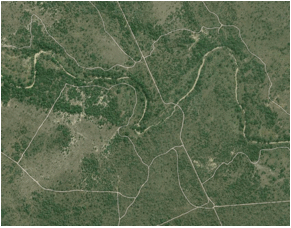
I pulled up the google maps at six o'clock this morning, before we left on our safari, and I saw that you would be hard pressed to walk very far at all around here without crossing a dirt road (you won't see pavement), though the telephone lines and cell towers are more localized. Yet on the road, we're tracking hyaena, giraffe, rhino.
(A mongoose just ran in front of me as I sit here writing. It's checking me out, the sun highlighting it's milk-chocolate back.)
Last night, just after dark, we were heading back to camp in the land rover when over the radio came news that one group had spotted a leopard. We used the dense road network I saw on my google satellite image to hightail it over to the action. Sure enough, we caught up with the two other land rovers that had been out on patrol and saw their spotlights sweeping the dense bushes. Yep, the leopards are here—not one, but two—just went off into the thickets. We smelled their pee, no doubt about it, there were big cats nearby.
The other land rovers pulled aside to give us a shot at the action, and then, right there in our tracker's spotlight, the leopards veered back onto the road, not a care in the world. Two of them, a male and a female, going about their boy-girl business, ambling in our headlight beam, with our big diesel-belching beast ambling right behind them. Those land rovers were part of their world for sure, though I suspect that if any one of us had stepped out of the truck, we wouldn't have been part of anybody's world for too long. After a hundred yards or so, the leopards turned back into the thickets, all to the tune of land rovers ahead bushwhacking overland to hopefully intercept them for a few more camera shots.
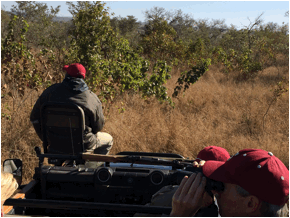
This morning, we drove back out there. It had been a cold night and was still a cold morning, and maybe because of that the animals, like us, were pretty quiet. A few impala, a few kudu, some zebra, and from a hill top where we stopped for a thermos of coffee, a wide, wide vista clear into Kruger Park. You couldn't actually see any roads from our vantage, though I knew from my map that they were certainly snaking all through that landscape, and as I sipped my coffee I pondered once again whether I was in a wild place or not.
There's no doubt people have played with this landscape, a lot. One reason there are all those roads is because in this area there are several different privately owned game reserves, just like the one we're staying at, each butting up against the next. We stay on our game roads, they stay on theirs. I was told this morning that one guy even brought in a few tigers, hoping to turn the Big Five into the Big Six (not extinctions, thankfully, here we're talking about the Big Five animals African hunters consider the most dangerous: elephants, water buffalo, rhinos, lions, and leopards). Luckily, the tigers haven't spread.
But the signs of humanity sure have, all through these game reserves, and that's affected the animals for both good and bad. You take your choice which is which. That big fence that separates the reserve lands from homelands, for instance. The lions know all about that. They drive their prey right into it. Great for the lions, of course. All those waterholes we drive by were dug out by bulldozers. Instead of a few natural waterholes where the African fauna would normally congregate, the new ones are spread out to bring animals to all the different game reserves, and even all the different parts of a given reserve. And the road network facilitates movement not only for our land rovers, but makes fast traveling for the animals too, as all those tracks show us on our bush walk.
That was a pleasant walk. It was hard not to feel like the place was wild when you were listening to the breeze, the crunch of our soles against the gravel, the swish of the dry grass against our legs, and when thinking about why our guide was carrying his rifle at the ready. But it was also hard not to notice that at some points we were walking beneath telephone wires, at others along a road, which twice we had to step off of as vehicles trundled past, their tire marks obliterating the fresh giraffe tracks.
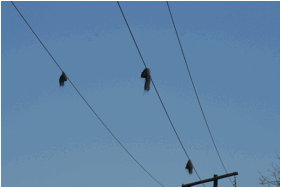
Maybe this sums it up. Hanging from the telephone wires were weaver bird nests. They've learned those wires are safer places than trees to build their nests, because no birds of prey can perch above them to swoop down at an inopportune time. So, despite the offense those telephone lines give to my eyes, it's all the same to the weaver birds, maybe even better. Same for that dense road network for many of the other animals.
So now I'm in a state of flux about what's wild. No doubt about one thing: if people disappeared from this landscape tomorrow, it would go right back to operating exactly as it has been for hundreds of thousands of years before, with pretty much the full complement of fauna and flora. Maybe that's all it takes to be wild, despite all the signs of people here.
The jury's still out for me on that one.
(Stay tuned for Part 3, in about a week.)
Musings on the Wild in Six Parts
Anthony Barnosky is a Professor in the Department of Integative Biology, Curator in the Museum of Paleontology, and Research Paleoecologist in the Museum of Vertebrate Zoology at the University of California, Berkeley.

His new book Dodging Extinction: Power, Food, Money, and the Future of Life on Earth (University of California Press, Fall 2014) explores in more detail the issues covered in this series of blogs, as well as other ways people can prevent the Sixth Mass Extinction.
First, a little background on these Musings on the Wild blogs. This summer I spent a couple of weeks as an ecotourist, traveling in Africa with a Stanford University Alumni Association trip. My wife, Liz Hadly, was the faculty leader, so even though I’m from UC Berkeley, they let me tag along.
The experience reinforced for me why it's so important to keep species like elephants, lions, and rhinos on Earth, and made me think long and hard about the difference between keeping species alive, and keeping wild places alive. The places we visited made it clear that it's certainly possible to do one without the other, but by the end of the trip, I was more convinced than ever that we need to do both.
In today's landscape of human domination though, what we're willing to accept as wild is up for grabs. What should we settle for? That question filled my thoughts for much of the two-week journey. This blog is the first in a series of six that tracks how my personal answer evolved as we travelled from Johannesburg, to Sabi Sabi Game Reserve in South Africa, to Victoria Falls in Zambia, to the Okavango Delta in Botswana.
Part 1. Fencing the Wild
When I was born there were over a million elephants roaming free in Africa. When my parents were born, there were more than that, and a million or so rhinos as well. In my all-too-short lifetime I've seen those elephant numbers more than cut in half. And rhinos, well, now there are maybe twenty thousand of those left, most of them in a single country, South Africa, and all of them in protected game reserves of one kind or another.
It's those kinds of stark facts that make me think that maybe what people tell me over and over is right. Maybe there is no more wild. But I still search for it.
That's what I'm doing this week, a couple of short hops in Africa, visiting some of those last wild places. First stop is Sabi Sabi Game Preserve, right on the border of Kruger National Park.
We left Johannesburg yesterday on a small turbo-prop, which flew high enough to give the umbrella view of this African landscape but not so high that you couldn't get a good sense of what was going on below. As we flew east and a little north, the high-rises, the electric-fenced middle-class neighborhoods, the gold-mine tailings, and the slums of old Soweto quickly gave way to another kind of landscape that also was totally made by humans.
Hundreds and hundreds of miles, as far as the eye could see, of parched brown farmlands. Admittedly, it’s winter here, maybe they look a lot more productive in the wet season. But I'm suspicious. It doesn't do much for my peace of mind about remaining wilderness. After all, nearly forty percent of Earth's lands now look like some version of this.

Another half hour or so of air time, and the farm country finally gives way to a cluster of coal-fired power plants, and I'm not sure if those are nuclear-plant stacks I see down there too. This time of year there is lots of burning of last year's vegetation, adding to the brown haze that stretches off to the horizon.
Now it's wilder looking land below, at least some geologic swirls breaking up the plain, and lots of green. Finally bushes, trees, grasses become more common than tilled fields. But still, the network of dusty brown roads is dense.
We're following a river now, with about twenty minutes to go--we've been in the air about an hour and a half. As the plane banks, dropping down as we near the Sabi Sabi landing strip, I notice a few giraffes loping along below. Stretched out on the river bank I make out a couple of hippos, with a few more mostly submerged in the green water.
Then we touch down, and climb into the land rovers. As we bounce towards the camp, our guide points out a few impala grazing on a burned field. "We burn that periodically, it makes the new grass come up, and the animals come in to eat the new shoots." Camp is not really the right word--it's much more elegant than that, complete with a spa. As we sip a mimosa on the deck, four elephants amble over to the water hole below. One of them is a baby, maybe six months or so old, and we watch it nurse, after its mother playfully blows some water out of her trunk.
 Later on during our evening safari, we
drive through some mowed fields. And we
notice the electric fences that separate the game reserve from the domestic
cattle in the nearby settlements. We
hear the cattle lowing, but don't see them.
Later on during our evening safari, we
drive through some mowed fields. And we
notice the electric fences that separate the game reserve from the domestic
cattle in the nearby settlements. We
hear the cattle lowing, but don't see them.
This is not my idea of wild, I'm thinking.
Yet, I'm thrilled. As the sun is going down, we're cruising in the land rover, and come up on a rhino. I'm seeing, up close and personal, something so rare my kids' kids may never see it--I'm staring at one of the last survivors of a species that's had ninety-eight percent of its kind wiped out.
 And it's staring right back at me. There's no doubt what that animal could do to
if we made a wrong move. It weighs
almost as much as our vehicle, and would have no hesitation in challenging us
if we gave it reason. That doesn't
happen of course. Our guide speaks
rhino, if you will, and can see it's a young male. He points out that the way it sniffs at the
midden of rhino dung, but doesn't make a deposit there, means that the rhino is
not about to let the dominant male in the area (whose midden it actually is)
think that he is making a play for the territory.
And it's staring right back at me. There's no doubt what that animal could do to
if we made a wrong move. It weighs
almost as much as our vehicle, and would have no hesitation in challenging us
if we gave it reason. That doesn't
happen of course. Our guide speaks
rhino, if you will, and can see it's a young male. He points out that the way it sniffs at the
midden of rhino dung, but doesn't make a deposit there, means that the rhino is
not about to let the dominant male in the area (whose midden it actually is)
think that he is making a play for the territory.
That rhino knows his place in nature. He may or may not know that probably the only reason he still has a place in nature is because he is being watched fairly closely, day and night, by some guy out there in camo who's on the lookout for poachers that would dearly love to put a bullet through the rhino’s brain and cut off his horn, for sale on the blackest of black markets.
We get up before dawn the next day, once again pile into the land rovers, and see two more rhinos, then a pride of lions sleeping in the sun. Three males, three females, a newly formed pride we're told, which coalesced after the males killed the cubs of the females a few months earlier. They're pretty skinny, not because there's not a lot to hunt, but because they've been too busy thinking about establishing their new social relationships to do as much hunting as they normally would. As we drive back to the camp, I'm struck again by the high electric fences.
After breakfast, we go for a short hike with our guide. Before we leave, he chambers four rounds into his .458-caliber rifle. Stay behind me, single file, he says. The signals are, one hand up, arm bent at the elbow, means stop. Same arm position, fist clenched, means bunch together. And whatever you do, don't run.
Lots of birds--horn bills, woodpeckers, hoopoes, orioles. The hot sun, the dry grass smells. Elephant tracks, elephant dung, it's winter dung because there are no dung beetles in it. Rhino, hippo, and hyaena tracks too. And leopard tracks, maybe the same one that caused the bush bucks in camp last night to let out an alarm call. We're getting a lesson in how the twigs of a certain tree can actually be used as a toothbrush, when one of us sees the elephant. It’s a gigantic animal, much bigger than they seem when viewed from the safety of a land rover. Its huge ears are flapping. How something so enormous can get so close without hearing it is a mystery, but there it is, and now we hear it, all right. It's crunching and breaking down trees, sounding like rifle reports as they snap. And it smells. Not bad, but I wouldn't say good either, very strong, a pungent odor something between leather, sweat, and marijuana smoke.

Now our guide takes the safety off his rifle and makes sure a round is ready to fire. Back up, slowly, don't run, and stay behind me. He whistles, shouts, tells the elephant we're there. What he tells us is that this elephant is very, very dangerous. He's a young male, in musth. As in, must have sex. When he smells like that, our guide tells us, even the females run away from him. So he gets more and more frustrated, and more and more angry, and he's ready to lash out at anything that gets in his way.
We walk, we don't run, and the elephant backs off. Afterwards we reflect on the very real danger that was there, and feel lucky to have experienced it.
We get back to camp, and wait for our guide to unhook the electric fence that separates our bungalows from where we saw the elephant. As I'm sitting here writing this, monkeys are dropping twigs around me as they jump around in the branches above my head.
And I'm still not sure. Is this wild, or is it not? Can you really have wild with a fence around it?
What to Expect When You’re Expecting Abrupt Climate Change
NOTE: The National Research Council recently published a report entitled Abrupt Impacts of Climate Change: Anticipating Surprises. Two of the authors, James W.C. White and Richard B. Alley, offer their perspectives on the report’s key messages in this blog. Sponsored by the U.S. intelligence community, the National Oceanic and Atmospheric Administration, the National Science Foundation, and the National Academies, the report summarizes current knowledge about the likelihood and timing of potential abrupt changes, and comments on their societal implications.

The plot twists and turns of the 2004 movie “The Day After Tomorrow” may be science fiction, but they were inspired by the science fact of the 12,000-year-old Younger Dryas event. The abrupt northern cooling into this millennium-long event, and even more abrupt warming as it ended, shifted climate around the globe and may have contributed to the extinction of numerous species of large-bodied mammals in North America.
The Younger Dryas gave us a valuable lesson on the possibility of abrupt climate change—shifts that occur so fast that ecosystems or economies have difficulty adapting. A recent National Research Council report, Abrupt Impacts of Climate Change: Anticipating Surprises, looks at abrupt changes that could take place this century and finds that concern is increasingly focused on the ability of even gradual climate change to force potentially damaging jumps in ecosystems and economies.
Superstorm Sandy overtopping the entrances to the New York subways and Hurricane Katrina breaching the levees of New Orleans are two examples of this: relatively slow sea-level rise, and perhaps gradual increases in the severity of large storms, helped trigger devastating damage to local infrastructure in just hours.
Consider also the Arab Spring, beginning in 2010, which toppled governments and sparked protests and rebellions across the Mideast and north Africa. Many social stresses contributed, but a spike in food prices was rather clearly involved in triggering unrest. This run-up in food prices in turn had many causes, but one contributor was the drought and heat wave of 2010 in the Russian wheat regions. And that in turn was made worse and/or more likely by human-caused global warming.
It is far, far too glib to draw a straight line from slowly rising CO2 to rapidly crumbling governments, but slow changes including those in climate did push the region across a threshold that triggered rapid, uncertain, and potentially costly changes. To borrow from the Pentagon, the changing climate is a threat multiplier.*
There is some good news in the report. Two decades of focused research have helped scientists determine that some abrupt changes once considered potential threats are unlikely to take place over the near term.
For example, extensive scientific research has shown that while freshening of the North Atlantic from Greenland melt and other processes is likely to cause regional changes and may have a broader footprint, Younger Dryas-type jumps are unlikely. Similarly, methane locked in sea-floor clathrates, and organic material in permafrost soils, can provide large and damaging positive feedbacks on global warming. But giant methane belches changing the climate greatly and rapidly are not expected because the system has safety valves that moderate the most extreme possibilities.
Research often works this way. Early attention is frequently focused on possibilities that may be very remote, but have very high impacts. Subsequent research typically narrows or eliminates the “fat tails” of this probability distribution, making the risk/benefit relationship clearer and more quantified, Such research can also lower costs. We buy insurance against low-probability/high-impact events, so narrowing the fat tails can improve our understanding of risks, providing better estimates of potential insurance costs for known risks and eliminating the need for insurance against possible outcomes now found to be too remote to warrant concern.
Occasionally though, subsequent research may find an answer out in one of the fat tails, motivating efforts to reduce risks (and thus insurance costs). So far, we cannot exclude this possibility for collapse of the West Antarctic ice sheet. The ice sheet has survived many millennia, and its modern mass losses are only a small fraction of the ongoing sea-level rise. These observations plus modeling suggest that the likelihood of rapid collapse in the very near future is probably low.
However, retreat of now-thinning Thwaites Glacier in West Antarctica from its current stabilized position could create a situation capable of calving icebergs more rapidly than anywhere on the ice sheet today by processes that may not be fully included in modern models. Even a relatively modest increase in the rate of sea level rise, for example three feet of sea level rise within thirty years (the period of a typical mortgage) instead of within 100 years—would be a game changer for our thinking about sea level rise. Further research will be required to narrow the very broad uncertainties in this case.
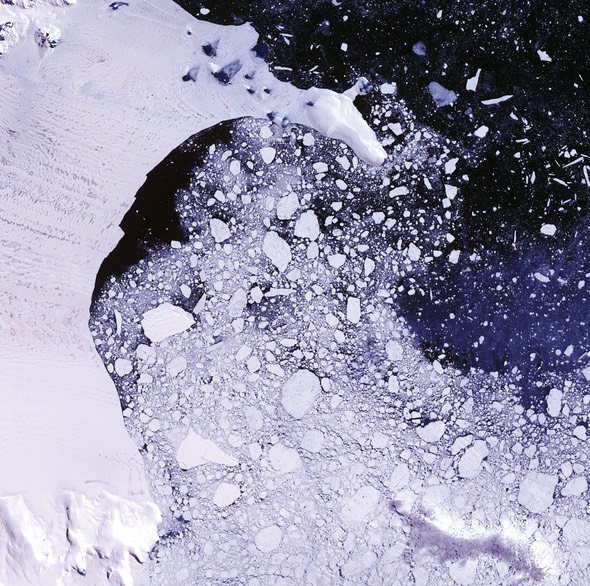
Among the unknowns: more-rapid-than-expected collapse of large ice sheets, as happened with the Larsen B Ice Shelf in Antarctica during one month in 2002 (photo courtesy of NASA). The impact would be faster sea level rise than models currently are predicting.
It is important to realize that abrupt change is not a far-off, future threat. Earth is already experiencing sudden increases in extinction rates and the rapid disappearance of late-summer Arctic sea ice.
Even if we take aggressive actions to slow greenhouse warming now, continued climate changes—both gradual and abrupt—are unavoidable. And an incremental shift could be all it takes to push a system across a threshold to abrupt change with devastating consequences.
The difference between a storm surge just below and just above a levee system can be measured in centimeters and billions of dollars—and the difference between a healthy ecosystem and the extinction of many species could come down to just one degree of temperature change. Absent efforts to anticipate and reduce vulnerabilities, Sandy in the subways and even the Arab Spring may be harbingers of events to come.
So what can we do to prepare for abrupt climate changes?
The report calls for an abrupt change early warning system to quantify assets and flag potential shifts in our environment, and help researchers and policymakers prioritize mitigation efforts. By preserving, maintaining and expanding our monitoring capability, targeting areas of greatest concern, and making data, decisions and warnings available in improved ways, many of the costs of expected and unexpected climate changes and their effects could be avoided or reduced.
We already have the capability to “stress test” human and natural systems, using science to learn where we are most vulnerable, and to guide informed choices to reduce those vulnerabilities. And advances in climate and weather forecasting, merged with advances in communicating forecasts and warnings to the public and policymakers, have reduced the potential damages from droughts, hurricanes, tornadoes, and other natural hazards. An abrupt change early warning system could extend those successful applications of science in the public good to reduce the most damaging impacts of the changing climate.
By James W.C. White (jwhite@colorado.edu) and Richard B. Alley (rba6@psu.edu)
White is a Professor of Geological Sciences and Director of the Institute of Arctic and Alpine Research at the University of Colorado. He chaired the committee that authored the NRC report. Alley is Evan Pugh Professor of Geoscience at Pennsylvania State University and one of the distinguished panel experts that authored the report.
Other References for This Piece:
* For the national security community’s discussion of “threat multipliers” see, for example, http://www.cna.org/reports/climate and http://www.scribd.com/doc/115962650/Global-Trends-2030-Alternative-Worlds
The 2013 NRC report updates a previous one published in 2002, entitled Abrupt Climate Change: Inevitable Surprises, from a National Research Council committee that was chaired by Richard Alley.
Otto, F.E.L., N. Masses, G.J. van Oldenborgh, R.G. Jones and M.R. Allen, 2012, Reconciling two approaches to attribution of the 2010 Russian heat wave, Geophysical Research Letters 39(4), doi:10.1029/2011GL050422
Sternberg, T., 2012, Chinese drought, bread and the Arab Spring, Applied Geography 34, 519-524
Beyond Science Communication: Informative versus Prescriptive Advocacy
A recent opinion piece by climatologist Michael Mann and a follow-up by environmental journalist Andy Revkin and environmental scientist Ken Caldiera raised the issue of how to tell the difference between communicating science, versus advocating for a cause.
We too have been forced to reflect on where that line lies as a result of our combined half-century of conducting research in the arena of global change science, coupled with our recent experiences working with politicians to develop and help them use the Scientific Consensus on Maintaining Humanity’s Life Support Systems in the 21st Century: Information for Policy Makers.
Our view is that communicating science means conveying relevant, accurate scientific information in ways that can be easily understood by the target audience.
Advocating for the use of science in decision-making is a slightly different beast—no longer is just pointing out the scientific realities the end goal. Rather, the point is to stress the importance of how scientific knowledge crystallizes looming problems and can contribute to their solutions.
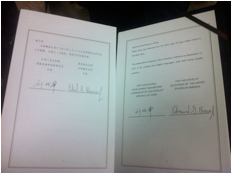
A memorandum of understanding between California and China to combat climate change. Such agreements must be based on sound science if they are to solve global problems, making it imperative for scientists to communicate what they know in effective ways.
But our recent experiences indicate to us that there are at least two kinds of advocacy when it comes to science: informative advocacy versus prescriptive advocacy. The difference is critical when engaging with policy makers and decision makers.
Informative advocacy as we see it is a close cousin to science communication without advocacy, in that it uses scientific knowledge to foretell the environmental (in our case) changes of probable societal relevance that lie ahead. It differs from pure science communication, which is simply to inform, in having an important goal of injecting the scientific realities into the many different categories of information that decision makers must take into account when formulating policy. Informative advocacy also has a second goal that is critical: learning from decision makers about the kind of information they need. This back-and-forth dialog ultimately opens new doors for decision makers to formulate solutions to complex problems, and new doors for scientists to understand how their science is socially relevant.
Prescriptive advocacy, in contrast, means using your position as a scientist to push for a particular policy action, which can do just the opposite of science communication or informative advocacy. We have found that prescriptive advocacy narrows choices for the decision makers, and often ignores harsh realities that especially elected officials face: a wide spectrum of societal views on what constitutes the most pressing needs, and economic and technological feasibility.
The lines between communicating science, informative advocacy, and prescriptive advocacy become clear by considering messages about and solutions to climate change. As an example of communicating science we point to the IPCC’s Summary for Policy Makers. Every effort is made to lay out the scientific realities, with minimal emphasis on telling policy makers what they ought to do.
As both communicating science and informative advocacy we cite the document we’ve built this website around, Scientific Consensus on Maintaining Humanity’s Life Support Systems in the 21st Century: Information for Policy Makers, which covers not only climate change, but also extinction, ecosystem loss, pollution, and population overgrowth. Scientifically sound broad-brush solutions are suggested, recognizing there are multiple paths to desired destinations. Engaging with policy makers in such ways is crucial, because dealing with the complexities of our multiple global challenges requires political will, not just data juggling.
An illustration of prescriptive advocacy is a letter we were asked to sign, as scientists who helped develop the Scientific Consensus Statement, to place a moratorium on fracking in California, on the grounds that fracking would purportedly exacerbate some of the overarching problems highlighted in the Consensus Statement, notably pollution and climate change. Regardless of our feelings about fracking as residents of the state, we did not sign that letter for two reasons. First, our scientific credentials do not extend to fully understanding the degree to which significant pollution would result—it may, but the scientific consensus has yet to consolidate on that point. (Also see Ken Caldiera’s comments on the temptation to extend your scientific credentials farther than is warranted).
Second, and perhaps more importantly, producing more natural gas from fracking may well be a necessary part of the solution in the transition from a fossil-fuel to carbon-neutral economy—if fracking is done in a way that does not pollute fracked areas, and if it is part of a plan to rapidly replace inefficient coal-burning power plants with cleaner-burning natural-gas facilities. The jury is still out on this hotly-contested issue, but it is clear that reaching the goal of a carbon-neutral energy system will require a multi-pronged approach through the transition period of the next decades, if the goal is to keep the lights on and our cars on the road at the same time carbon-neutral technologies are ramping up. Taking any potentially feasible options off the table at this critical juncture in fact handicaps decision makers, rather than helping them.
In essence, communicating science involves boiling down the discoveries of the practicing scientific community to their accurate bullet points, and highlighting the societally relevant impacts. Informative advocacy involves taking that science to decision-makers (and the general public), and pointing out scientifically sound paths to desired destinations. But it is left to the decision makers (often our elected officials) to decide which of the multiple pathways to solving a particular problem are the most practical to pursue, taking into account the layout of the entire constituency landscape.
Communicating science and informative advocacy identifies destinations and available paths, but does not barricade some paths in favor others.
Prescriptive advocacy, on the other hand, is all about making arguments that your path is better than any other one. The problem with prescriptive advocacy is that you can tie the hands of decision makers, making it more difficult for them to find the best route through what is usually a complex maze of needs and opportunities.
While in our view the lines between communicating science, informative advocacy, and prescriptive advocacy are sharp, they nevertheless can be easily crossed. All three have their roles in bringing scientific realities into the decision-making process and the public arena, of course. But, it is helpful to recognize which one you’re doing when.
By Elizabeth A. Hadly, hadly@stanford.edu and Anthony D. Barnosky, barnosky@berkeley.edu
Elizabeth Hadly is a Professor of Biology and Senior Associate Vice Provost for Undergraduate Education at Stanford University. Her research focuses on ecological and evolutionary impacts of global change. Further information is available from her website. You can follow her on Twitter @LizHadly.
Since 1990, Anthony Barnosky has been on the faculty at the University of California, Berkeley. He is a paleoecologist who studies how global change impacts species and ecosystems. Further information is available from his website. You can follow him on Twitter @tonybarnosky.
Our new moon shot: Restore the climate by 2070
We can restore the climate of the 1980s by 2070. It won’t require a miracle or big sacrifices, just the will and policies to do it. Top climate scientists confirm this is possible.
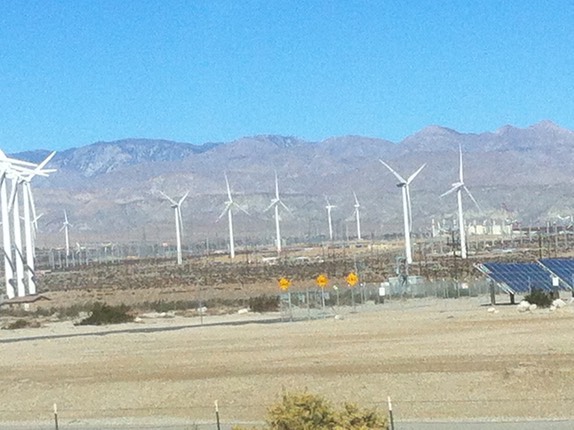
Restoring the climate requires that we switch to carbon-free energy by 2030-2050, as described by Stanford’s Prof. Mark Z. Jacobson, and let the ocean continue absorbing the carbon dioxide we've emitted.
In 1961, President Kennedy declared: “We will send a man to the moon and bring him back safely by the end of the decade.” At the time we had just sent a man into space for 15 minutes. We did not have the rockets, the navigation or the life support systems for a moon trip and most people, including my parents, thought it was complete folly. Seven years later we had developed and demonstrated the technology -- ahead of schedule. We had a clear ambitious goal and a deadline, and we rose to the occasion.
We can do that again with the climate. Shifting the world’s energy from fossil fuels to renewables could be accomplished before 2045, with CO2 levels peaking about 430 parts per million. That is up from 280 ppm a hundred years ago, 400 ppm now, and our goal of 350 ppm, which is considered to be a safe level and last seen in 1988.
Scientists and skeptics agree that about half the CO2 emitted globally has been absorbed by the oceans already, and expect that half of future emissions will be absorbed over the next 25-35 years. The oceans will continue to acidify, and the only way to slow that is to reduce emissions. We might even decide to actively remove CO2 from the atmosphere to hasten a restored climate. If so, there are dozens of companies working on it and we have dozens of years to perfect some creative methods.
The shift to renewables would be accomplished mainly by using wind and solarpower. Only wind and solar are ready for utility scale now at the low costs we need. The market will decide which alternative sources, such as biofuels or nuclear, may become cheaper and better over time.
Wind generation has been growing at over 25% per year for the last six years. It provides 3% of our country’s electricity now. If we maintain that growth rate, it will provide 50% in 2025. This would be something like 2,000 modern 5-megawatt turbines per state. Solar provides 1% of our electricity now, and is growing at over 50% per year. If we keep up that pace, it will produce the other 50% of our electricity by 2025. China is already building panels at ten times the US rate, so catching up to and even surpassing their production is plausible. Efficiency improvements will provide at least a 30% reduction in our requirements. For example cars are slated to double their mileage by 2025 and LED lights are now ten times more efficient than old incandescent bulbs.
Twenty years is plenty of time to develop the missing links such as batteries, smart grids and domestic manufacturing capability. Compare that to the 5 years we spent building the 300,000 aircraft that helped us win WW II, using 1940’s technology, or the 7 years developing the technology for the moon program with 1960’s technology. We now have Google, computers, 3D printers, and millions of highly educated engineers connected by the internet.
The looming issue is the rapidly growing CO2 emissions in China and India. China is working hard to slash its fossil fuel consumption and severe air pollution--since 2012 China has been building more new wind capacity than new coal and the New York Times reports that China is expected to reduce its net coal imports to zero by 2015. India’s neighbor, Bangladesh, has set an example by installing solar roofs at a rapid pace, without subsidies, thereby skipping the development of expensive and unreliable utility and fossil fuel infrastructure. They already have 2.5 million solar roofs powering LED lights, phones, refrigerators, and TVs. This is fifteen times as many as California has now. As solar panel production soars, its cost plummets — it is below the cost of fueling kerosene lamps in most developing countries, and will soon fall below the cost of utility electricity in the cities. For that reason, India is now starting work on the world’s largest solar plant—4 gigawatts.
Switching to renewables will create many local jobs in the US, while costing some fossil fuel jobs. It will stabilize energy prices because the sun and wind are free and the technology costs are steadily decreasing. It is shown to increase network reliability because with thousands of solar panels and wind turbines, the loss of a few has little effect.
We can restore the climate if we want to, or continue on the conservative path Exxon CEO Rex Tillerson and the Koch brothers understandably suggest: Debate the science and adapt to climate change. Let other countries invest in and master renewable energy technology. The trillions of additional dollars to adapt to the worsening climate and rising seas will come out of public and private funds, not theirs.
Tell your children, President Obama and your representatives which legacy you want to give to our grandkids: Restore the climate by 2070. That is our moonshot. Let’s commit to it. There is room for small government fans and everyone else to contribute in this game.
By Peter Fiekowsky, pfieko@gmail.com. Peter Fiekowsky is a physicist, business owner, and volunteer for Citizens Climate Lobby.

